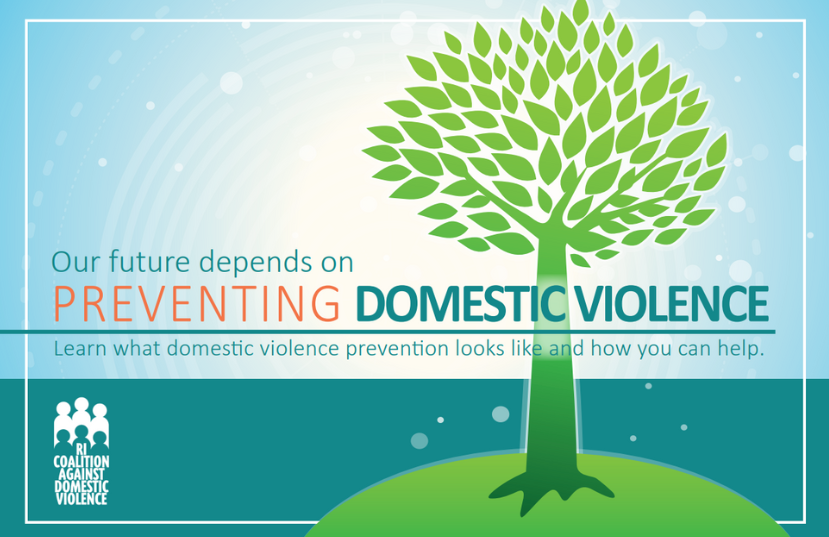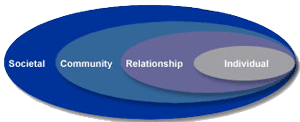What is Primary Prevention?
Address the Root Causes of Violence
Address the Root Causes of Violence
Create Supportive,
Safe Environments
Primary Prevention

In order to truly end domestic violence, we need to change the attitudes and behaviors that perpetuate abuse, build connection within our communities, and improve quality of life for all people.
To learn more about primary prevention strategies, check out the RICADV’s resource, Our Future Depends on Preventing Domestic Violence.
To request a hard copy, please contact the RICADV at 401-467-9940 or ricadv@ricadv.org.
Types of Prevention
Primary
- Any action, strategy or policy that works to stop domestic violence from occurring in the first place.
- Primary prevention seeks to reduce the overall likelihood that anyone will become a victim or perpetrator of domestic violence by creating conditions that make violence less likely to occur.
Secondary
- Secondary prevention is intervening and responding to violence that has already occurred in order to stop violence from happening again.
- Secondary prevention activities can include shelter, counseling, safety planning, and protective orders.
Tertiary
- Tertiary prevention focuses on ongoing support to victims and ongoing accountability for abusers.
- Tertiary prevention activities address the long-term consequences of domestic violence. They can include support groups and other resources for survivors to help them heal so that they do not experience abuse again. They can also include batterers intervention programs for abusers to prevent them from continuing to perpetrate violence in the future.
The Social-Ecological Model
To stop a problem like domestic violence before it begins, we must understand the factors that influence the problem.
The Social-Ecological Model provides a framework for understanding the factors that promote or prevent domestic violence and how we should approach the primary prevention of this issue.

This model considers the complex ways that individual, relationship, community, and societal factors intersect, helping us address the factors that either put people at risk of or prevent people from experiencing or perpetrating relationship violence.
The Individual level of the social-ecological model considers biological and personal history factors, such as age and history of abuse. Prevention strategies at this level often aim to promote attitudes, beliefs, and behaviors that ultimately prevent violence, such as through education or life skills training.
Prevention strategy at the Individual level: A program in schools that helps students develop skills to build positive, healthy relationships
The Relationship level of the social-ecological model considers the influence of social circles, including peers, partners and family members, on behavior and experience. Prevention strategies at this level may work to cultivate conflict resolution and problem solving skills while promoting healthy relationships, such as through mentoring or peer programs.
Prevention strategies at the Relationship level: A mentor program that pairs adults with at-risk youth; training on child-rearing
The Community level of the social-ecological model considers the environments in which our social relationships exist, such as schools and workplaces, and their impact on our behaviors. Prevention strategies at this level work to impact the climate and processes of organizations, such as through workplace policy change or public awareness campaigns.
Prevention strategies at the Community level: Helping community members design and paint a mural, build a youth center, or host a forum about domestic violence or related issues
The Societal level of the social-ecological model considers the broad societal factors that help create a climate where violence is either encouraged or inhibited, such as health, economic, and educational policies. Prevention strategies at this level work to impact the climate and policies of systems, such as through legislative initiatives.
Prevention strategy at the Societal level: Advocating for legislation that creates greater equality among different groups in society
Risk & Protective Factors
We can use our knowledge of the risk and protective factors that exist across levels of the social-ecological model to better address the issue of domestic violence from a primary prevention perspective.
For example, because we know that youth is a risk factor – a characteristic that can make it more likely for someone to become a victim or perpetrator of relationship violence – we can focus on educating and skill-building with youth about healthy relationships.
Because we know that economic independence is a protective factor – a characteristic that can make it less likely for someone to become a victim or perpetrator of relationship violence – we can focus on increasing financial literacy in our communities.
Social Change
The primary prevention of domestic violence aims to create social change. Through various initiatives, we are working to cultivate individuals and communities that do not tolerate violence and that support healthy relationships and gender equality.
Imparting knowledge and raising awareness is not enough to create social change. In order to achieve this peaceful vision for the future, we must work to shift deeply ingrained attitudes, beliefs and behaviors that contribute to the problem of domestic violence. To do so takes time, practice and multiple opportunities for skill-building and communicating with others during the learning process.
A public health approach to prevention utilizes methods from a range of fields and delivers various positive messages over time through leaders and role models, both individuals and organizations. This model has successfully addressed other prevention issues, including seatbelts, car seats, helmets, and smoking, and in turn has created safer, healthier communities. In applying a public health approach to domestic violence, we seek to identify the root causes of behaviors, the conditions in our communities that condone or promote domestic violence and the strategies that might change those conditions.
A public health model and the RICADV’s approach to prevention also acknowledges the ways that different oppressions, such as racism, sexism, and classism, intersect with domestic violence. Understanding and challenging where power and resources exist is critical if we are to build a community that values each person and does not tolerate any form of violence.
Helpline Available 24/7
The confidential statewide Helpline can be reached by calling 1-800-494-8100 or using the online chat here. The Helpline is for all victims of violent crime, including domestic and dating abuse, and those looking for more information to help a victim of violence.